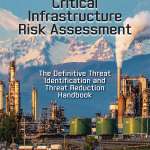Seaports – A Very Constricted Critical Infrastructure
by Ernie Hayden, MIPM CISSP GICSP(Gold) PSP
Seaports should not be ignored in your critical infrastructure risk assessment.
The news has been full of stories about the challenges at the world’s seaports. In particular, the Covid-19 pandemic has emphasized the prominent position seaports and their associated logistical support networks play in our global economy.
For instance, did you know that according to the World Bank, maritime transport carries more than 80 percent of the global merchandise trade by volume? And, that approximately 35 percent of total merchandise volumes (plus over 60 percent of commercial volume) are carried by containers? Thus, container ports are extremely critical nodes in global supply chains and networks and are central to the growth strategies of national economies.
Again, according to the World Bank, how a maritime port performs is a critical element in the cost of international trade for a country. Unfortunately, seaports and container terminals can often be sources of shipment delays, supply chain disruption, increased shipping and handling costs, and reduced national competitiveness. Because of the interconnected nature of global shipping, deficient performance at one port can disrupt shipment handling schedules at other seaports.
Container Port Performance Index (CPPI)
In 2020, the World Bank’s Transport Global Practice published its inaugural edition of the Container Port Performance Index, otherwise known as the CPPI. The CPPI was developed with the intention of identifying gaps and opportunities for improvement at container ports. As stated by the World Bank, “…the CPPI is intended to serve as a reference point for key stakeholders in the global economy, including national governments, port authorities and operators, development agencies, supranational organizations, various maritime interests, and other public and private stakeholders in trade, logistics, and supply chain services.” Hence the CPPI for each port can be compared to other seaports relative to container handling performance and efficiency.
Of note, the CPPI can be categorized by a Statistical Approach or Administrative Approach. This blog will focus on the Statistical Approach rankings and the reader is advised to view the World Bank report to learn more about the different approaches and the scoring methodology.
Regardless of the differences in the approaches, perhaps the CPPI can be a useful tool for today’s challenges caused by Covid? Perhaps we can use the CPPI to gain a perspective on where US ports stand relative to the rest of the world?
Port Performance
When evaluating the CPPI, one can observe that the top-ranked container ports in 2020 are Yokohama (Japan) in first place followed by King Abdullah in Saudi Arabia. Halifax, Canada is the highest ranked port in North America, ranked 39th by the Statistical Approach.
According to the CPPI co-author, IHS Markit, East Asian container ports are the most efficient in the world and dominate the top 50 spots of the new global CPPI. Key port performance metrics such as minutes per container move show large discrepancies in global port efficiency, with top performers such as Yokohama taking just 1.1 minutes on average to load or unload a container in a standard port call while the average for equivalent workloads in African ports is more than three times that at 3.6 minutes.
Currently, the US-centric news is about the container handling performance of the national ports such as Los Angeles-Long Beach, New York-New Jersey, etc. However, the table below shows where the US ports are when compared to Yokohama and key Asian seaports.
| Seaport (Not All Inclusive of CPPI List) | CPPI Statistical Approach (2020) |
| Yokohama, Japan | 1 |
| Hong Kong | 7 |
| Singapore | 15 |
| Shanghai | 63 |
| US – Philadelphia, Pennsylvania | 83 |
| US – Port of Virginia | 85 |
| US – New York-New Jersey | 89 |
| US – Charleston, South Carolina | 95 |
| US – Mobile, Alabama | 101 |
| US – Boston, Massachusetts | 113 |
| US – Baltimore, Maryland | 138 |
| US – Wilmington, North Carolina | 155 |
| US – Jacksonville, Florida | 161 |
| US – Miami, Florida | 200 |
| US – Tampa, Florida | 226 |
| US – Seattle, Washington | 236 |
| US – New Orleans, Louisiana | 265 |
| US – Houston, Texas | 266 |
| US – Savannah, Georgia | 279 |
| US – Dutch Harbor, Alaska | 325 |
| US – Los Angeles, California | 328 |
| US – Oakland, California | 332 |
| US – Long Beach, California | 333 |
| US – Tacoma, Washington | 335 |
| Ngqura, South Africa | 351 (Last Place) |
As you can see the US ports tend to be in a range of 83rd place to 335th. Unfortunately, one of the key ports of concern – Los Angeles due to its receipt of goods from Asia – is 328th place.
CBS 60 Minutes Review of US Container Port Challenges
On November 14, 2021, the CBS television show 60 Minutes broadcasted a 13-minute video essay entitled “Packed ports and empty shelves: Inside the issues behind the U.S. supply chain crisis.” The article opened with a question about what is causing the US’ supply chain crunch. The review included examination of the Port of Los Angeles and the challenges with efficient and effective movement of containers.
Note that the issues causing the US supply chain “crunch” are complex and this author is by no means an expert on all facets of the malady in play; however, when looking at the CPPI and the comments in this news article, it causes one to wonder about ways to increase the efficiency of the ports and how they handle the containers and the ships carrying them.
For instance, the Port of New York-New Jersey is the largest cargo port on the US East Coast. In 2019, the port moved over a record 7.4 million TEUs (Ten-foot Equivalent Units) of cargo. They are ranked 89th in the CPPI. However, the Port of Los Angeles handled 9.3 million TEUs, yet they are ranked 328th in the CPPI.
One question to ask is if there is any merit trying to transfer knowledge and experience from the Port of New York-New Jersey to the Port of Los Angeles just to improve the CPPI and the speed of container handling?
Is Port Ownership the Problem?
Finally, in the CBS 60 Minutes review, Ryan Peterson, CEO of Flexport, observed that the newly signed infrastructure bill may not be enough to upgrade the country’s container ports. Peterson does not think that $17 billion is adequate.
For instance, Peterson observed that Singapore (Ranked #15 in the CPPI) is investing $20 billion in its container terminal at this time. That is for one port that handles 37.2 million (TEUs) of containers in 2019. Compare $17 billion spread out across at least 20 US seaports – that appears to be horribly inadequate.
Peterson also indicated that in the US the ports are owned by the cities they are in. Hence, the capital expenditure for building seaport terminals, investing in the port infrastructure, etc. comes down to decisions made at a local level and not at a coordinated, national level. Hence, Peterson sees the funding of ports and their infrastructure is more of a role for the US Federal Government and not for the local government.
Where to Next?
This article started with the World Bank’s new methodology to compare container port performance in a manner that compares apples to apples.” This appears to be a head start but also shows how the US container ports are woefully behind the rest of the world – especially East Asia.
Additionally, this article discussed the concerns about port ownership and whether or not the Federal Government is adequately providing direction for a comprehensive and nationally strategic approach versus local.
Finally, there may be opportunities to exchange knowledge and even management expertise from the US – and maybe international ports – to help ports like the Port of Los Angeles to improve its efficiencies and CPPI numbers.
Again, a complex problem that requires many ideas to help better understand the causes of the problems with container handling and then find solutions.
Ernie Hayden, MIPM, CISSP, GICSP(Gold), PSP is a highly experienced and seasoned technical consultant, author, speaker, strategist and thought-leader with extensive experience in the power utility industry and critical infrastructure protection and risk assessment. Hayden is a certified physical and cyber security expert with specific expertise in industrial controls security.
Ernie is author of the new book, Critical Infrastructure Risk Assessment: The Definitive Threat Identification and Threat Reduction Handbook.
VOTED ASIS INTERNATIONAL SECURITY INDUSTRY BOOK OF THE YEAR!
Click HERE to receive a free chapter!
In this chapter — The Power of the Observation — you will discover:
- An overview of the concept of an “observation.”
- The primary elements included in the observation as well as its format.
- Fundamental considerations when performing and documenting the observation including the power of one’s influence on the actions being observed, the need for critical thinking, and considerations on how the observation supports the risk assessment.
#erniehayden #criticalinfrastructure #infrastructure #riskassessment


